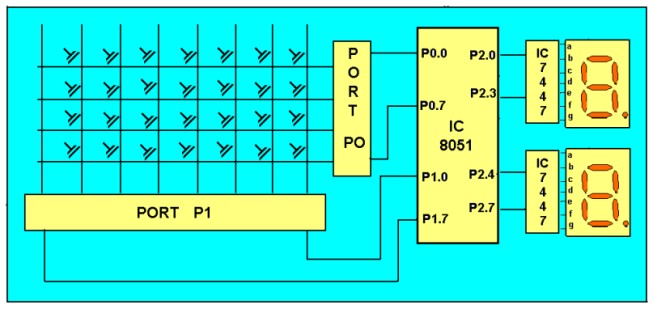Theoretical Paper
- Computer Organization
- Data Structure
- Digital Electronics
- Object Oriented Programming
- Discrete Mathematics
- Graph Theory
- Operating Systems
- Software Engineering
- Computer Graphics
- Database Management System
- Operation Research
- Computer Networking
- Image Processing
- Internet Technologies
- Micro Processor
- E-Commerce & ERP
Practical Paper
Industrial Training
I/O Interfacing and Ports – Keyboard Interfacing
The key board here we are interfacing is a matrix keyboard. This key board is designed with a particular rows and columns. These rows and columns are connected to the microcontroller through its ports of the micro controller 8051. We normally use 8*8 matrix key board. So only two ports of 8051 can be easily connected to the rows and columns of the key board.
When ever a key is pressed, a row and a column gets shorted through that pressed key and all the other keys are left open. When a key is pressed only a bit in the port goes high. Which indicates microcontroller that the key is pressed. By this high on the bit key in the corresponding column is identified.
Once we are sure that one of key in the key board is pressed next our aim is to identify that key. To do this we firstly check for particular row and then we check the corresponding column the key board.
To check the row of the pressed key in the keyboard, one of the row is made high by making one of bit in the output port of 8051 high . This is done until the row is found out. Once we get the row next out job is to find out the column of the pressed key. The column is detected by contents in the input ports with the help of a counter. The content of the input port is rotated with carry until the carry bit is set.
The contents of the counter is then compared and displayed in the display. This display is designed using a seven segment display and a BCD to seven segment decoder IC 7447.
The BCD equivalent number of counter is sent through output part of 8051 displays the number of pressed key.

The programming algorithm, program and the circuit diagram is as follows. Here program is explained with comments

Keyboard is organized in a matrix of rows and columns as shown in the figure. The microcontroller accesses both rows and columns through the port.
The 8051 has 4 I/O ports P0 to P3 each with 8 I/O pins, P0.0 to P0.7,P1.0 to P1.7, P2.0 to P2.7, P3.0 to P3.7. The one of the port P1 (it understood that P1 means P1.0 to P1.7) as an I/P port for microcontroller 8051, port P0 as an O/P port of microcontroller 8051 and port P2 is used for displaying the number of pressed key.
Make all rows of port P0 high so that it gives high signal when key is pressed.
See if any key is pressed by scanning the port P1 by checking all columns for non zero condition.
If any key is pressed, to identify which key is pressed make one row high at a time.
Initiate a counter to hold the count so that each key is counted.
Check port P1 for nonzero condition. If any nonzero number is there in [accumulator], start column scanning by following step 9.
Otherwise make next row high in port P1.
Add a count of 08h to the counter to move to the next row by repeating steps from step 6.
If any key pressed is found, the [accumulator] content is rotated right through the carry until carry bit sets, while doing this increment the count in the counter till carry is found.
Move the content in the counter to display in data field or to memory location
Start of main program:
to check that whether any key is pressed
start: mov a,#00h
mov p1,a ;making all rows of port p1 zero
mov a,#0fh
mov p1,a ;making all rows of port p1 high
press: mov a,p2
jz press ;check until any key is pressed
after making sure that any key is pressed
mov a,#01h ;make one row high at a time
mov r4,a
mov r3,#00h ;initiating counter
next: mov a,r4
mov p1,a ;making one row high at a time
mov a,p2 ;taking input from port A
jnz colscan ;after getting the row jump to check
column
mov a,r4
rl a ;rotate left to check next row
mov r4,a
mov a,r3
add a,#08h ;increment counter by 08 count
mov r3,a
sjmp next ;jump to check next row
after identifying the row to check the colomn following steps are followed
colscan: mov r5,#00h
in: rrc a ;rotate right with carry until get the carry
jc out ;jump on getting carry
inc r3 ;increment one count
jmp in
out: mov a,r3
da a ;decimal adjust the contents of counter
before display
mov p2,a
jmp start ;repeat for check next key.

